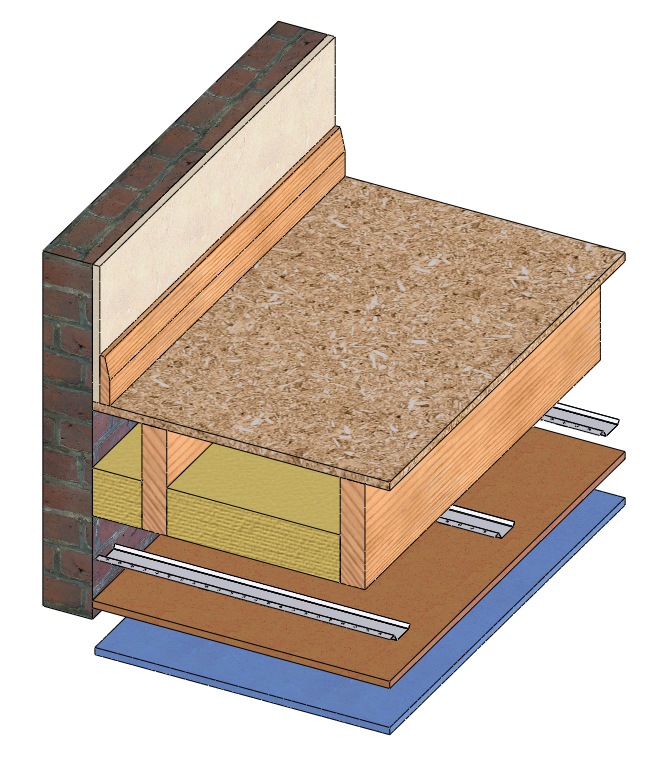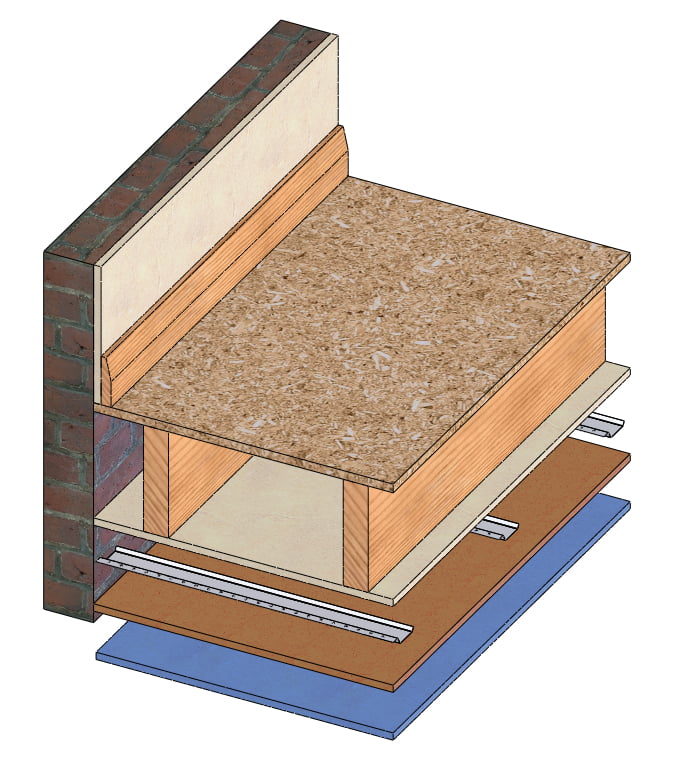Soundproofing Timber Ceilings with PhoneStar
Soundproofing Timber Ceilings
There are two methods for sound insulating timber or metal joist ceilings. PhoneStar acoustic insulation gives excellent results at reducing both airborne sound (such as conversation, television or music noise) and impact sound (such as footstep noise or items being dropped upstairs) that travels through timber or metal joist ceilings. Standard timber joist ceilings generally do not provide good acoustic insulation due to their lightweight structure. The PhoneStar board adds significant mass to the ceiling structure due to its high density, high mass and loose, soft silica sand filling.
The best way to reduce impact sound is to lay a resilient layer upstairs directly beneath the finished floor covering to absorb the footstep noise before it gets into the floor structure in the first place. However, soundproofing your ceiling may be your only option if you have no access to the floor above e.g. in apartment dwellings.
There are two options for soundproofing timber ceilings and if possible we recommend that you choose Option 1 which requires the existing ceiling finish to be removed.

Downloads:
Option 1 - Optimum Solution
Decoupled & Exposed Timber Ceiling Solution
Thickness: 44 – 61mm on Ceiling Below
Expected Impact Sound Improvement: 14 – 17 dB approx.
- Expected Airborne Sound Improvement: 16 – 18 dB approx.
This solution requires that any existing plasterboard or finishing board be removed first from the ceiling because this can vibrate off the walls, sending noise down the walls. In addition, it will create a sound-bridge because it is fixed directly to the joists. This optimum solution requires PhoneStar sound insulation boards to be installed on to resilient bars which are fixed to the underside of the timber joists. We highly recommend filling the ceiling cavity with high density mineral wool to reduce echoes and reverberation. The resilient bars are thin, steel channels that absorb vibrations and greatly reduce sound transmission through the ceiling. This system involves adding a heavy, but soft, product to the ceiling as well as decoupling the ceiling, so these are the essential elements required to provide very effective acoustic insulation through ceilings.

Construction from Top Down
- Timber or metal joist floor with ceiling plasterboard etc removed
- 50 – 100mm high density mineral wool (45kg/m³) in between joists
- 16mm standard Resilient Bars
- 15mm PhoneStar TRI Acoustic Insulation
- 12.5 or 15mm acoustic plasterboard and skim
- Optional second layer of plasterboard for improved fire and acoustic rating
Have you also considered Flanking Noise? Flanking Noise is important to consider when installing sound insulation.
Please download the full Installation Instructions for Soundproofing Ceilings before commencing work.
- 100mm high density (45kg/m³) mineral wool between joists
- Resilient bars Ref: RB1 (3M x 75mm x 16mm deep)
- Drywall screws to secure resilient bars to joists
- PhoneStar TRI Acoustic Insulation (1200mm x 800mm x 15mm)
- PhoneStar Eco-Tape (50mm x 50M)
- Drywall screws (25mm length) to secure PhoneStar to resilient bars
- 12.5 or 15mm acoustic plasterboard and skim – 1 or 2 layers
- Drywall screws (38mm length) to secure plasterboard to resilient bars
- Acoustic or Intumescent Sealant
- Remove the existing plasterboard and sealant at perimeter.
- Fill the void between the joists with 100mm x 45kg/m³ high-density mineral wool.
- Secure the resilient bars at 400mm centres and perpendicular to the underside of the joists with drywall screws. Ensure bar ends do not touch the perimeter walls – leave a 5mm gap. Note: the first and last bars should be approximately 50mm clear of the nearest walls.
- Screw PhoneStar into the resilient bars with 25mm drywall screws and ensure the screws do not touch the timber joists. Leave screw heads just below the board surface. Butt each PhoneStar board up tightly to each other and do not leave any gaps between, or around, the PhoneStar layer. Install the boards in a brickwork formation.
- See Cutting and Taping PhoneStar Guide on last page of Installation Instructions.
- Screw plasterboard through PhoneStar into the resilient bars with 38mm drywall screws, being careful to stagger joints and leaving a 5mm perimeter gap around the perimeter walls.
- Seal 5mm perimeter gaps with acoustic or intumescent sealant.
- Finish the plasterboard as required.
- Consider treating any identified flanking walls with PhoneStar.
Option 2 - Very Good Solution
Decoupled Timber Ceiling with Plasterboard Solution
Thickness: 44 – 61mm on Ceiling Below
Expected Impact Sound Improvement: 14 – 17 dB approx.
- Expected Airborne Sound Improvement: 15 – 17 dB approx.
This solution is used when it is not practical to remove the existing plasterboard or lath and plaster finish etc from the ceiling. This means that you cannot place mineral wool in the cavity so there may still be reverberation noise in the empty cavity. This option requires PhoneStar sound insulation boards to be installed on to resilient bars which are fixed to the underside of the plasterboard etc. The resilient bar fixings will need to be secured through the plasterboard into the joists above. Resilient bars are thin, steel channels that absorb vibrations and greatly reduce sound transmission through the ceiling. This system involves adding a heavy, but soft, product to the ceiling as well as decoupling the ceiling, so these are the essential elements required to provide effective sound insulation through ceilings.

Construction from Top Down
- Timber or metal joist floor with ceiling plasterboard, lath and plaster etc left in place
- 16mm standard Resilient Bars
- 15mm PhoneStar TRI Acoustic Insulation
- 12.5 or 15mm acoustic plasterboard and skim
Have you also considered Flanking Noise? Flanking Noise is important to consider when installing sound insulation.
Please download the full Installation Instructions for Soundproofing Ceilings before commencing work.
- Resilient bars Ref: RB1 (3M x 75mm x 16mm deep)
- Drywall screws to secure resilient bars to joists
- PhoneStar TRI Acoustic Insulation (1200mm x 800mm x 15mm)
- PhoneStar Eco-Tape (50mm x 50M)
- Drywall screws (25mm length) to secure PhoneStar to resilient bars
- 12.5 or 15mm acoustic plasterboard and skim
- Drywall screws (38mm length) to secure plasterboard to resilient bars
- Acoustic or Intumescent Sealant
- Leave the existing plasterboard etc in place if it is not practical to remove it and ensure that it is sound by removing any loose material.
- Optional if enough available room height: Make a timber frame independent ceiling below the current ceiling and fill this with high density (45kg/m³) mineral wool. If doing this follow instructions from Option 1.
- Secure the resilient bars at 400mm centres and perpendicular to the underside of the joists with drywall screws through the plasterboard and into the joists above. Ensure bar ends do not touch the perimeter walls – leave a 5mm gap. Note: the first and last bars should be approximately 50mm clear of the nearest walls.
- Screw PhoneStar into the resilient bars with 25mm drywall screws ensuring these do not touch the plasterboard. Leave screw heads just below the board surface. Butt each PhoneStar board up tightly to each other and do not leave any gaps between, or around, the PhoneStar layer. Install the boards in a brickwork formation.
- See Cutting and Taping PhoneStar Guide on last page of Installation Instructions .
- Screw plasterboard through PhoneStar into the resilient bars with 38mm drywall screws, being careful to stagger joints and leaving a 5mm perimeter gap around the perimeter walls.
- Seal 5mm perimeter gaps with acoustic or intumescent sealant.
- Finish the plasterboard as required.
- Consider treating any identified flanking walls with PhoneStar.

